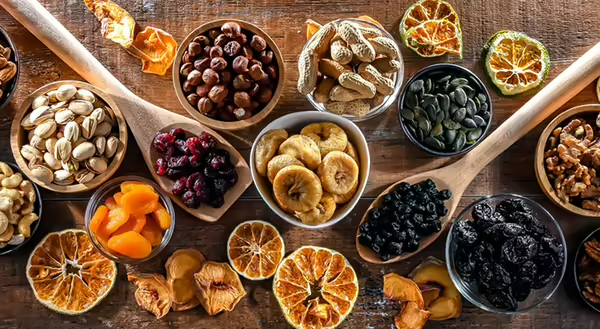
Dry or low moisture foods do not quickly come to mind when we think about foodborne illnesses and the ways to reduce them. In fact, these foods are not among the top three foods linked to foodborne disease outbreaks in the United States. Dry or low moisture foods include grains, nuts, nut products, baked goods, herbs, spices, infant formula, dried fruits and dried vegetables among others. Water, which is one of the key factors that promotes growth of harmful microorganisms in food, is not adequately available in dry or low moisture foods. So, why are there outbreaks linked to low moisture foods?
Well, preserving food by drying or dehydration removes water that harmful microorganisms would use to grow, however, it does not completely eliminate microorganisms that were present before drying or those that are introduced during or after the drying process. It is important to know that harmful microorganisms can survive in dry or low moisture foods for long periods of time and can multiply when conditions become favorable.
Activities such as soaking in water that is sometimes done to grains, nuts, pulses, and seeds, and hydration or reconstitution where water is added to food powders and dried foods can increase food safety risks if not performed properly. This becomes even more critical when handling or preparing foods that will not be cooked before consumption.
Use the tips below to reduce chances of foodborne illnesses related to dry or low moisture foods at home.
- If drying your own foods, make sure to wash hands with clean water and soap, use clean utensils, do not use damaged raw ingredients as they may be contaminated, and store dried foods in closed containers to prevent entry of contaminants or water.
- Animal sourced foods such as meats should be cooked before drying to kill harmful microorganisms that may be present.
- Foods such as grains, nuts, pulses, and seeds to be soaked should have been treated to eliminate harmful microorganisms. If you are not sure how to do this, you can treat them using hot water at 60 C (140 F) for 3 to 10 minutes.
- Wash the seeds, nuts, or pulses with clean water to remove dirt and debris before soaking.
- Soaking and hydration should be done using water that is safe to drink.
- Soaking and hydration should be performed under refrigeration temperatures.
- Follow the Food and Drug Administration’s dos and don’ts when handling flour and flour-based food products.
- Follow the Centers for Disease Control and Prevention’s tips when using powdered infant formula
References and Resources
- Efficacy of heat treatment in the reduction of salmonellae and Escherichia coli O157:H– on alfalfa, mung bean and radish seeds used for sprout production
- Foodborne Illness Outbreaks Reported to National Surveillance, United States, 2009–2018
- Handling Flour Safely: What You Need to Know
- Infant Formula Preparation and Storage
- Persistence of Salmonella and Other Bacterial Pathogens in Low-Moisture Foods
- Practice and Progress: Updates on Outbreaks, Advances in Research, and Processing Technologies for Low-moisture Food Safety
- Safe Minimum Internal Temperature Chart